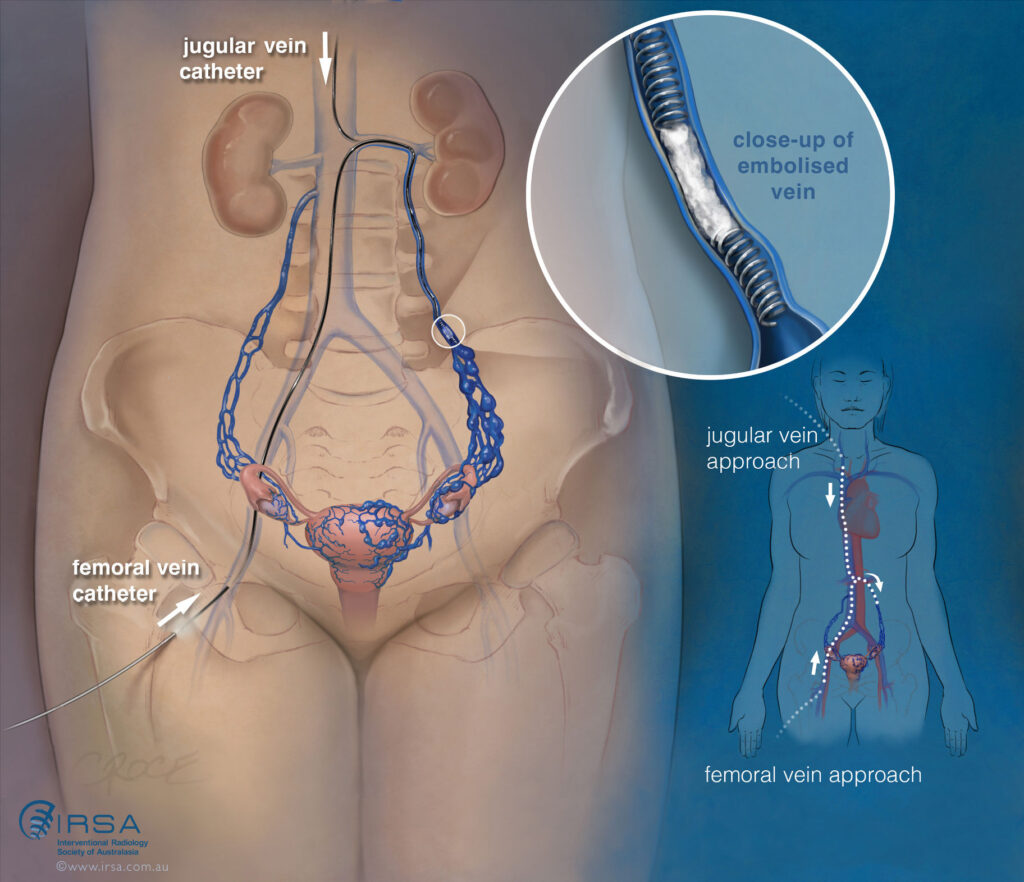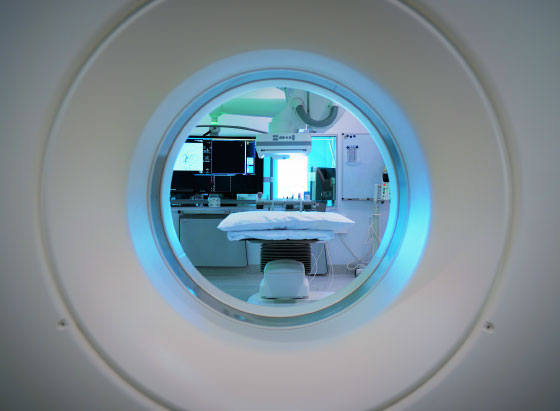Interventional Radiology
Ovarian Vein Embolisation Procedure
If you’re exploring treatment options for pelvic congestion syndrome, you may have heard of ovarian vein embolisation. This minimally invasive procedure, performed by highly skilled interventional radiologists, helps relieve the discomfort caused by faulty veins in the pelvis. The Interventional Radiology Society of Australasia (IRSA) can guide you to find the right doctor for your needs in Australia or New Zealand.
What is Ovarian Vein Embolisation?
Ovarian vein embolisation is a non-surgical, image-guided interventional radiology procedure that addresses faulty varicose veins in the pelvis, particularly ovarian veins, which can contribute to pelvic congestion syndrome. During this interventional radiology procedure, a radiologist uses a small catheter to place a coil or other substance into the affected veins, blocking blood flow to the problem areas. This helps reduce pain and discomfort by preventing blood from pooling in the veins.
Why Would My Doctor Refer Me for This Procedure?
Pelvic congestion syndrome (PCS) can cause chronic pelvic pain due to enlarged varicose veins in the pelvic region. When traditional treatments fail to alleviate the discomfort, your doctor might refer you to an interventional radiologist for ovarian vein embolisation. This procedure is a safe and effective alternative to surgery, with minimal recovery time, allowing you to return to your daily activities quickly.

Wondering If You Qualify for OVARIAN VEIN EMBOLISATION?
About the Procedure
Diagnosis
Before the procedure, your doctor will likely conduct a series of diagnostic tests, such as ultrasound, Computed Tomography (CT scans), or Magnetic Resonance Imaging (MRIs), to confirm that PCS is the source of your discomfort.
Preparation
You’ll be advised to fast for six hours before the procedure, though you may take routine medications with a sip of water. You might also be instructed to temporarily stop blood-thinning medications.
Procedure
Once you arrive at the hospital, a small area near your upper thigh or neck will be numbed with a local anaesthetic. A thin catheter will then be inserted through a vein and guided to the pelvic veins under X-ray imaging. If malfunctioning veins are identified, the radiologist will place coils or inject a solution to close off the affected veins to reduce blood flow in this area.
Recovery
After the procedure, you’ll rest in the hospital for a few hours before being discharged. It’s essential to avoid driving and strenuous activities for at least 24 hours. Some mild discomfort is one of the most common side effects of ovarian vein embolisation, but over-the-counter pain relievers can help manage it. Full recovery typically takes about two days.

Benefits of
Ovarian Vein Embolisation Interventional Radiology Procedures
Ovarian vein embolisation is a highly effective treatment for PCS, with an 83% success rate. Unlike open or traditional surgery, which require more extensive recovery time and carry higher risks, this minimally invasive procedure that uses magnetic resonance imaging guidance allows patients to experience significant relief from pelvic pain and varicose veins without a long hospital stay. It’s important to consult a specialist to ensure that ovarian vein embolisation is the right treatment for your specific condition.
Risks of Ovarian Vein Embolisation
While these interventional radiology procedures like pelvic blood vessel embolisation are generally safe, there are a few potential risks to be aware of:
- Bruising at the site of the catheter insertion
- Back and pelvic ache
- Rare complications like allergies or vascular injury
In very rare cases, a coil used in the procedure may migrate to the lung, potentially causing a mild cough or chest discomfort. However, these instances are uncommon, and the benefits of this minimally invasive treatment often outweigh the risks for those suffering from PCS.
How Long Does It Take to See Results?
Improvement can begin within weeks, though the full benefits may take up to six months. Some patients may notice mild discomfort during their next menstrual cycle as the body adjusts. Every patient is different, so your response to the treatment may vary. Your interventional radiologist will guide you through what to expect during recovery from blood vessel embolisation and provide follow-up care.
Find an Interventional Radiologist
IRSA’s “Find a Doctor” tool is here to help you locate qualified interventional radiologists specialising in ovarian vein embolisation in Australia or New Zealand. This tool provides a comprehensive database, allowing you to search based on geographic location and area of practice. Take the first step towards relief from pelvic congestion syndrome by finding a specialist who understands your needs and can guide you through your treatment options.
FAQs
What is pelvic congestion syndrome?
Pelvic congestion syndrome is a condition where varicose veins in the pelvic area cause chronic pelvic pain. It mainly affects women, especially those who have had multiple pregnancies, as the blood vessels can become enlarged and congested over time. This persistent discomfort can significantly impact daily life, but a minimally invasive treatment like ovarian vein embolisation from an interventional radiologist offers effective relief by addressing the underlying issues caused by enlarged pelvic veins, cutting off their blood flow.
How do I know if I’m a candidate for ovarian vein embolisation?
If you’ve been diagnosed with PCS and have not found relief through other treatments, your doctor may refer you to an interventional radiologist who can assess whether ovarian vein embolisation is right for you. Find a qualified interventional radiologist in Australia or New Zealand through the IRSA.
Is ovarian vein embolisation painful?
This interventional radiology procedure is generally well-tolerated. You’ll receive a local anaesthetic at the insertion site, and many patients experience only mild discomfort afterward. Any pain typically resolves within a week or two.
What should I expect during recovery?
You’ll be observed for a few hours post-procedure and can usually go home the same day. You may experience mild pelvic discomfort, which can be managed with over-the-counter medications. Full recovery from ovarian vein embolisation side effects typically occurs within a few days.
Are there any long-term side effects of an interventional radiology ovarian vein embolisation?
As this is a minimally invasive treatment option, most interventional radiology patients do not experience long-term side effects, and the procedure is considered safe. Follow-up with your interventional radiologist is essential to ensure the best possible outcome.
How effective is ovarian vein embolisation compared to surgery?
Ovarian vein embolisation by interventional radiologists is as effective as surgery in treating pelvic congestion syndrome, offering a similar success rate. However, it is a less invasive procedure using imaging guidance, which means patients experience a quicker recovery and face fewer complications than with surgery. Interventional radiology makes embolisation of these painful blood vessels an appealing alternative for many, providing effective relief with minimal downtime.
Where can I find an Interventional Radiology specialist for ovarian vein embolisation?
Use the IRSA “Find a Doctor” tool to locate interventional radiologists in Australia or New Zealand who specialise in ovarian vein embolisation. This tool will help you find an interventional radiology doctor near you who can guide you through the diagnosis, treatment, and recovery process.
